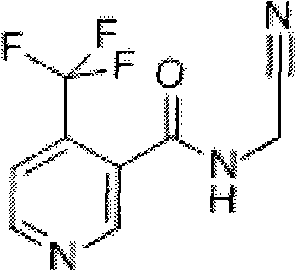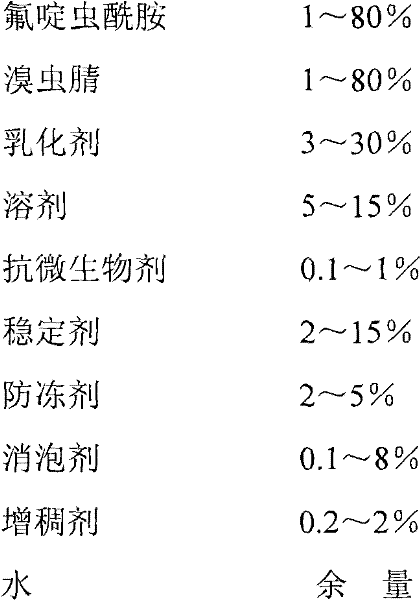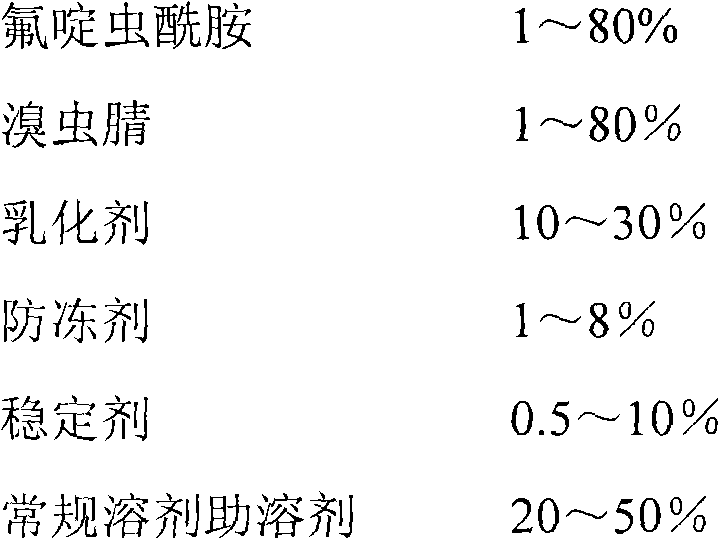A kind of insecticidal composition containing flonicamid and chlorfenapyr
The technology of an insecticidal composition and flonicamid, which is applied in the field of pesticide compounding, can solve the problems of serious pest resistance, decreased pesticide control effect, etc., and achieves long lasting effect, great agricultural production significance, and reduced pesticide usage. Effect
- Summary
- Abstract
- Description
- Claims
- Application Information
AI Technical Summary
Problems solved by technology
Method used
Image
Examples
Embodiment approach
[0014] In one of the technical solutions of the present invention, the insecticidal composition is an emulsion in water, and the weight percentage of the components is:
[0015]
[0016] The specific production steps of the emulsion in water are as follows: first, the original drug flonicamid, chlorfenapyr, solvent, emulsifier, and co-solvent are added together to dissolve into a uniform oil phase; Microbial agents and other pesticide additives are mixed together to form a uniform water phase; while stirring at high speed in the reactor, add the oil phase to the water phase, slowly add water until the phase inversion point is reached, and turn on the shearing machine for high-speed shearing. And add the remaining water, cut for about half an hour to form an oil-in-water emulsion. A water emulsion of the composition of the present invention can then be prepared.
[0017] In the second technical scheme of the present invention, when the described insecticidal composition is ...
example 1
[0048] (1) Test drug
[0049] 96% flonicamid technical, Japan Ishihara Sangyo Co., Ltd., 94.5% chlorfenapyr technical, BASF Europe.
[0050] Dissolve the original drug with acetone first, and mix the appropriate amount of the two original drugs into 5 different ratios according to the results of the preliminary experiment, and then use acetone to dilute each treatment into 5 series of concentration gradients for use. The ratios of the active ingredients of the five flonicamid and chlorfenapyr in different proportions were 3:12; 5:10; 7:8; 9:6; 11:4 and were diluted into 5 series of concentration gradients for use.
[0051] (2) Test target
[0052] Beet armyworm, beet armyworm raised for generations indoors, indoor conditions: temperature (26±2)°C. The relative humidity is 70%±5%, and the photoperiod is 16 / 8h (L / D).
[0053] (3) Test method
[0054] In this test, the worm body immersion method was used. First, dilute the mother liquors of flonicamid and chlorfenapyr to 5 c...
example 2
[0072] (1) Experimental test agent
[0073] 96% flonicamid technical, Japan Ishihara Sangyo Co., Ltd., 94.5% chlorfenapyr technical, BASF Europe.
[0074] (2) Test target
[0075] Wheat aphids were collected from the field population of the wheat experimental field of Qingdao Agricultural University, and wingless adult aphids of the same individual size were selected for testing. Experimental method is the same as activity determination example 1
[0076] (3) Toxicity test results and analysis:
[0077] Table 2 Indoor determination results of flonicamid and chlorfenapyr on wheat aphids
[0078]
[0079] It can be seen from the table that the co-toxicity coefficients of the mixtures in different proportions are all greater than 120, showing a certain synergistic effect. Obviously, the co-toxicity coefficient is 161.34. The test results show that both chlorfenapyr and flonicamid have high activity against wheat aphids under indoor conditions. When nitriles were diluted ...
PUM
 Login to View More
Login to View More Abstract
Description
Claims
Application Information
 Login to View More
Login to View More - R&D
- Intellectual Property
- Life Sciences
- Materials
- Tech Scout
- Unparalleled Data Quality
- Higher Quality Content
- 60% Fewer Hallucinations
Browse by: Latest US Patents, China's latest patents, Technical Efficacy Thesaurus, Application Domain, Technology Topic, Popular Technical Reports.
© 2025 PatSnap. All rights reserved.Legal|Privacy policy|Modern Slavery Act Transparency Statement|Sitemap|About US| Contact US: help@patsnap.com



